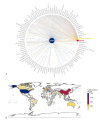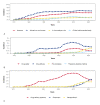Nanotechnologies in Obstetrics and Cancer during Pregnancy: A Narrative Review
- PMID: 36013273
- PMCID: PMC9410527
- DOI: 10.3390/jpm12081324
Nanotechnologies in Obstetrics and Cancer during Pregnancy: A Narrative Review
Abstract
Nanotechnology, the art of engineering structures on a molecular level, offers the opportunity to implement new strategies for the diagnosis and management of pregnancy-related disorders. This review aims to summarize the current state of nanotechnology in obstetrics and cancer in pregnancy, focusing on existing and potential applications, and provides insights on safety and future directions. A systematic and comprehensive literature assessment was performed, querying the following databases: PubMed/Medline, Scopus, and Endbase. The databases were searched from their inception to 22 March 2022. Five independent reviewers screened the items and extracted those which were more pertinent within the scope of this review. Although nanotechnology has been on the bench for many years, most of the studies in obstetrics are preclinical. Ongoing research spans from the development of diagnostic tools, including optimized strategies to selectively confine contrast agents in the maternal bloodstream and approaches to improve diagnostics tests to be used in obstetrics, to the synthesis of innovative delivery nanosystems for therapeutic interventions. Using nanotechnology to achieve spatial and temporal control over the delivery of therapeutic agents (e.g., commonly used drugs, more recently defined formulations, or gene therapy-based approaches) offers significant advantages, including the possibility to target specific cells/tissues of interest (e.g., the maternal bloodstream, uterus wall, or fetal compartment). This characteristic of nanotechnology-driven therapy reduces side effects and the amount of therapeutic agent used. However, nanotoxicology appears to be a significant obstacle to adopting these technologies in clinical therapeutic praxis. Further research is needed in order to improve these techniques, as they have tremendous potential to improve the accuracy of the tests applied in clinical praxis. This review showed the increasing interest in nanotechnology applications in obstetrics disorders and pregnancy-related pathologies to improve the diagnostic algorithms, monitor pregnancy-related diseases, and implement new treatment strategies.
Keywords: assisted reproduction technology; diabetes; fetal growth; fetal growth restriction; fetal therapy; nanoparticle; nanotechnology; preeclampsia; pregnancy; preterm birth; preterm labor.
Conflict of interest statement
The authors declare no conflict of interest.
Figures



References
-
- Khan K.A., Petrou S., Dritsaki M., Johnson S.J., Manktelow B., Draper E.S., Smith L.K., Seaton S.E., Marlow N., Dorling J., et al. Economic costs associated with moderate and late preterm birth: A prospective population-based study. BJOG. 2015;122:1495–1505. doi: 10.1111/1471-0528.13515. - DOI - PubMed
-
- Chawanpaiboon S., Vogel J.P., Moller A.-B., Lumbiganon P., Petzold M., Hogan D., Landoulsi S., Jampathong N., Kongwattanakul K., Laopaiboon M., et al. Global, regional, and national estimates of levels of preterm birth in 2014: A systematic review and modelling analysis. Lancet Glob. Health. 2019;7:e37–e46. doi: 10.1016/S2214-109X(18)30451-0. - DOI - PMC - PubMed
Publication types
LinkOut - more resources
Full Text Sources

